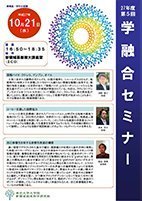AY2015 5th Gakuyugo Seminar
- Date&Time:
- Oct 21, 2015 16:50~18:35
- Venue:
- Large Lecture Room (2C0), New Frontier Science Bldg.

Algae bio: Chlorella, starch, oil
Professor Shigeyuki Kawano
Most of the oxygen in the atmosphere, the chalk coast, and even shale gas are derived from microscopic algae, less than 1/10th of a millimeter in size, that have proliferated on the earth during the geological era. Algae have an established reputation for their ability to produce materials, and the realization of carbon-neutral material production and green energy through "algae biotechnology" is eagerly awaited. In this article, I would like to explain how to make chlorella produce starch and oil. Chlorella is a microalgae that we are now familiar with because of its high protein content, and its cultivation and research began after the war as a food resource.

International Cooperation through Coffee
Professor Yukio Ikemoto
Coffee is grown in the highlands of the so-called "coffee belt" between the Tropic of Cancer and the Tropic of Cancer. in the early 2000s, world coffee prices plummeted and coffee producers in developing countries were suffering from poverty. At that time, consumers in developed countries began to support coffee producers through activities such as fair trade. This presentation will explain the background and current status of such activities, and consider how such activities can lead to poverty reduction.

Construction of non-adherent surfaces with self-healing properties
Associate Professor Hideaki YokoyamaHigh-density grafted polymer chains are known to be effective in dispersing colloids, inhibiting protein adsorption, and reducing the coefficient of friction in liquids such as water. Conventional polymer brushes are made by either the "graft-to" method, in which one end of the polymer chain is chemically or physically bonded, or the "graft-from" method, in which the polymer chain is living polymerized from a starting point on the surface. In our group, we have developed an alternative method to the "graft-to" method. In our group, as a third method different from these methods, we have created a dynamic polymer brush system that is spontaneously formed by the segregation phenomenon of amphiphilic diblock copolymers in elastomers to the water interface. The hydrophilic blocks, which have a high surface energy, avoid the surface in air and hide in the bulk, but when the surface comes into contact with water, they segregate and cover the interface, and the hydrophobic blocks act as anchors to prevent them from escaping completely into the water, thus dynamically forming a polymer brush layer. The dynamic polymer brushes are characterized by their self-healing function, because even if the surface copolymer is worn away, new copolymer is supplied from the bulk.
*The contents of this page were developed based on a machine translation.

